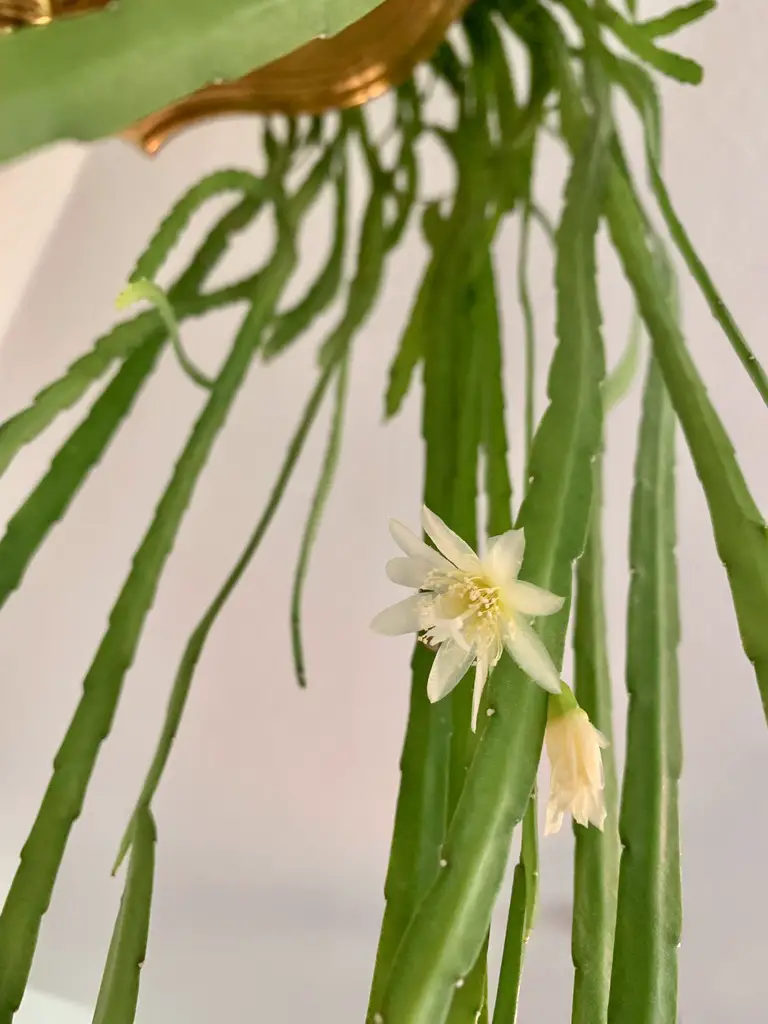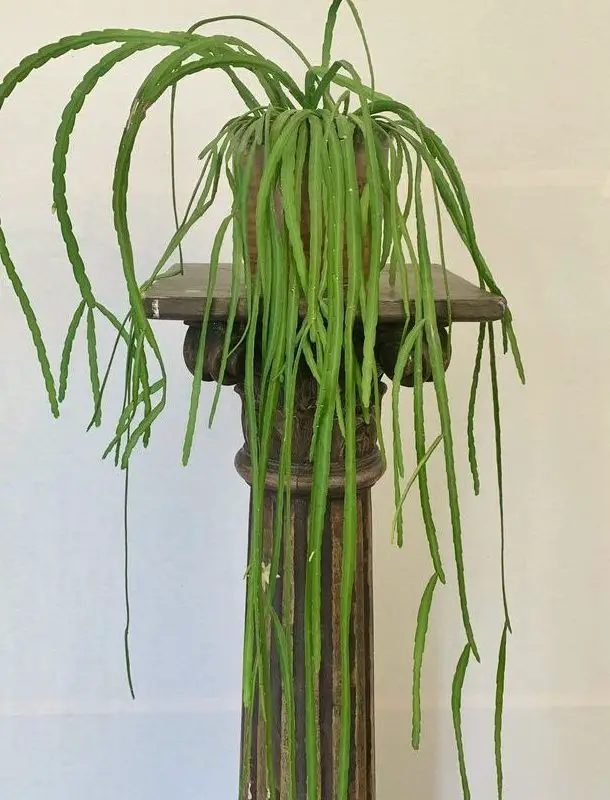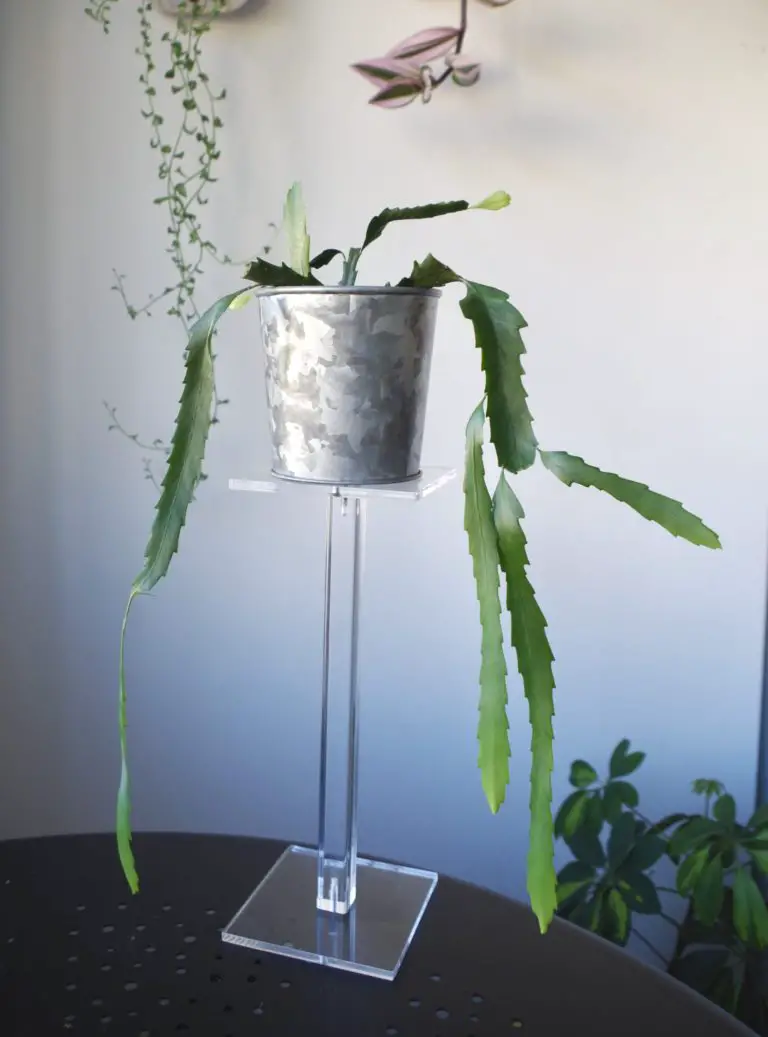Lepismium Bolivianum is a hanging epiphytic cactus. Characterized by long green branches, from which new growth appears in an angled fashion. The interesting growth pattern and easy care requirements of this plant make it a perfect houseplant. Given the right conditions, Lepismium Bolivianum will also bloom multiple times a year adding to its allure.
Lepismium Bolivianum Care: Plant Lepismium Bolivianum in airy, fast draining soil. Place in bright to medium indirect light, avoiding any direct sun, and provide temperatures between 50-75F. Allow the plants’ soil to completely dry out between waterings.
About Lepismium Bolivianum
Botanical Name: Lepismium Bolivianum, Pfeiffera Boliviana
Common Name: Forest Cactus, Hanging Tree Cactus
Family: Cactaceae
Origin: Bolivia
This cactus is an epiphytic cactus, meaning in its natural habitat it is most often found growing on trees, tall plants, or other structures above the ground. Lepismium Bolivianum, also known as Pfeiffera Boliviana or Forest Cactus, is notably grown for its long, flat branches. The branches grow in an angled fashion with somewhat jagged edges. New branches, as well as flowers, form from the creases of the jagged edges, as shown in the picture below.
When flowering, Lepismium Bolivianum produces small to medium-sized creamy white flowers. Most often this cactus will bloom in spring and early summertime. It’s important to give your cactus some rest and cut back watering during the winter. Allowing the plant to go dormant will increase the likelihood of prolific flowering come spring.

Lepismium Bolivianum Light Requirements
Unlike many other cacti, the Forest cactus prefers a shady spot in your home. Ideally, you can provide your Lepismium Bolivianum with bright to medium indirect light. This means a few feet back from a window that receives direct sunlight, or directly in a north-facing window.
While it can handle some early morning sun or dappled sunlight, it can quickly become sun-scorched. If the plant is receiving too much direct sun it will begin to have a red hue to its foliage. If it continues to receive harsh sun after it has turned red you risk sun-damaged, brown, burnt foliage which is irreparable.
It is worth noting that Lepismium Bolivianum can also survive in lower light conditions. If you place your plant in an area receiving low amounts of light make sure to water less to avoid any problems with root rot.
When To Water Pfeiffera Boliviana
Being an epiphytic cactus, Lepismium Bolivianum is semi drought tolerant. It is best to allow the plants’ soil to dry out completely between waterings. With this type of plant, it is always better to under-water rather than to be too heavy-handed. You should also consider the location of your plant to assess its watering needs. If it sits in a bright spot that receives some direct sun it may need watering twice as frequently as the same plant sitting in a spot receiving medium indirect light
The most common issues with Lepismium Bolivianum stem from overwatering or inadequate soil. Signs of overwatering include yellowing and/or shriveling foliage, mold on soil, and little new growth. A foul smell near the soil may also indicate root rot. If you think your plant is suffering from overwatering, allow the soil to thoroughly dry out, then assess its roots for rot or damage.

Humidity Preferences
Average indoor humidity will suit Lepismium just fine. It is just important to avoid placing it near heaters or AC vents, as extremely dry air won’t benefit healthy growth.
If you notice your plants’ foliage is developing brown, crispy edges it may be a good idea to place a pebble tray with water beneath its pot. Alternatively, you can group your Lepismium with other plants or place it near a humidifier to counteract the lack of humidity.
Temperature Requirements
Lepismium Bolivianum prefers a mild climate making it suitable for most homes. Temperatures between 50-75F are ideal. It’s best to avoid placing it near any drafty windows or doors to mitigate any problems with leaf drop.
If your climate allows for this plant to be kept outdoors, make sure to place it in a shady spot. Keep your eyes on the weather forecast as Lepismium Bolivianum is extremely frost-sensitive. A short period of near-freezing temperatures is enough to decimate its foliage and may damage the plants’ roots as well.
Lepismium Bolivianum Toxicity
Lepismium Bolivianum is classified as non-toxic.
It is not toxic to cats or dogs either. While non-toxic it is still important that your pet doesn’t eat large amounts of this plant as it may still cause discomfort or mild nausea.

Lepismium Flowers
Once Lepismium is mature it will flower in late spring and summer. It produces small to medium-sized white flowers that grow directly from the foliage. The flowers usually open slightly staggered and remain for about a week or two. Altogether the plant can flower for several weeks and multiple times each growing season.
How To Propagate Lepismium Bolivianum
The best way to Propagate is via stem cuttings.
- Start by choosing a healthy stem that shows no signs of damage. An ideal stem would have a nice green color and be free of any brown, damaged, or yellowing spots.
- Once the right stem is chosen cut the stem with sterile scissors or shears to avoid any problems from bacteria.
- Cut the stem into multiple smaller sections and allow the sections to callus over for at least a day. Make sure to remember which way the cuttings grew, it’s important to face them correctly in the soil.
- Prepare a pot with airy, fast-draining soil. I’d also recommend using a terra-cotta pot to avoid issues with rotting due to too much moisture.
- Once the cuttings have callused over, place them in the soil, covering about the bottom ¼” with soil. Place the pot and cuttings in a bright spot and continuously mist or water, to keep the soil slightly moist.
- After a few weeks to a month, your cuttings should have roots. At this point, you can transplant them or allow them to stay in the same pot. Once roots have formed you can allow the soil to dry out more.



